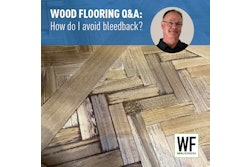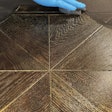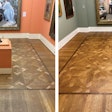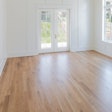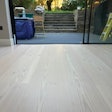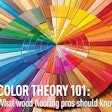
Here in Colorado, our wood flooring market is super traditional—red oak strip is the standard floor. You'll get a few herringbones here and there, but for the most part it's hard to convince consumers in this area to even do a border or anything with a custom design. Our market is also a big stain market, so about 95% of my jobs involve using a stain, and I've found that doing interesting stain samples is one way to impress customers, set myself apart on social media and give myself a break from the same-old, same-old when banging in strip flooring.
I started doing unique stain samples about four years ago after I saw someone post a stain sample in the shape of a pumpkin online. I asked the guy if he would mind if I did one, too, and he said, "No, man, do it—I'm glad someone wants to do something different." After that I just never stopped. Here's how I handle doing stain samples with my customers and use them to my advantage.
1) I ask for specific colors up front.
I try to get a really good idea of what colors they are interested in before I'll create samples. I have them email or text pictures to me, or I'll send the customers to my distributor to either get actual samples or take pictures to send to me. Then I'm able to see the tones they are interested in and tell them if those colors are possible or not possible on their species. With the pink tones in red oak, you can't do as much as you can with white oak, although the products today give you a lot more options. These days I have a lot of requests for light grays, but I try to stay away from bleaching because I trowel-fill all my floors, and bleach dissolves the filler. Especially when we're dealing with a really gappy existing floor, that can be an issue—I like my floors to look like pianos when I'm done with them. So, I discuss the possibilities with the customers long before I put stain samples on their floors.
 My first four sample colors are $25, but I charge $100 per color after that.
My first four sample colors are $25, but I charge $100 per color after that.
2) I charge for samples.
I charge customers $25 for the first four color samples, and after those initial four it goes up to $100 per color. I find that if you don't charge for samples, customers will just keep going and asking to see how it looks a little lighter, a little darker, etc., etc. If they know they have to spend money on more samples, though, they spend a lot more time up front finding the color they really want.
I'd estimate that 99% of the time my customers pick one of the first four stain samples. About 15% of my business is working with interior designers, and sometimes when I give them my bid, they'll have me add on an extra $500 right away for stain samples—but then they always seem to end up going with one of the first four samples I do anyway.
3) I create interesting samples in a short amount of time.
I usually don't have a plan ahead of time when I do the custom samples. I start with the floor final-prepped and water-popped exactly as it will be when I'm doing the actual job so the color will be accurate. If I'm doing one of my circle designs, I start with a hole punch, a string and a pen, and then I'll add some fun wavy lines or whatever my design is. I usually use blue tape in whatever width I happen to have at the time (I've even used masking tape). The key is to get the tape down well and then not soak the edges of the tape with the stain, because stain will work its way under that tape, and I want it to look as crisp as possible.
RELATED: Get a Handle on Wood Floor Staining Strategies
4) I have customers sign off on the samples.
I try to do a pretty large sample so the customer can get a good idea of what the color is going to look like in their house. I always remind them to imagine, especially if it's a dark color, what it's going to look like covering their entire floor. Sometimes, particularly if it's a jacobean or ebony, they'll be surprised how dark it really looks once it's down. After they've chosen their color, I have them sign the color chart and put the color in the contract. I write down the exact ratio of the stain so I have it in the future and they also have it as a reference.
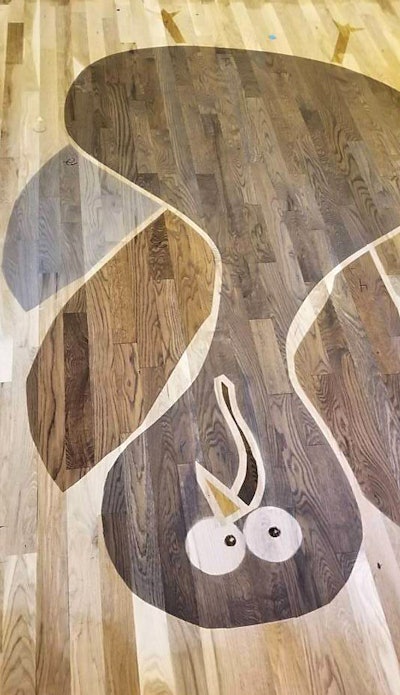 A favorite custom stain sample was a turkey I did based on a drawing by my daughter.
A favorite custom stain sample was a turkey I did based on a drawing by my daughter.
5) I post my stain samples on social media.
I used to just do typical squares or rectangles, but now customers see my stain samples on Instagram, and it gets them excited about their wood floors and creates an expectation about my company. They think, "If he spends that much time on the stain sample, how good are the floors going to look? They'll be amazing." A funny thing about this is that because they're excited to see what their sample will be, I can't just be in a hurry and do a square, or they're kind of like, "You don't think we're special?" The pumpkin I posted was a big hit, and a favorite of mine was a turkey I did around Thanksgiving. It was based on a turkey that my daughter drew in school, and the homeowner was all excited about it (I may have gotten a little carried away on that one!). I really like doing the circles with the patterns in the middle, too.
Some wood flooring pros on social media have asked me why I waste my time doing these samples, but they really don't take much more time than doing typical stain samples, and they give me and my customers something fun and creative to look forward to.

















